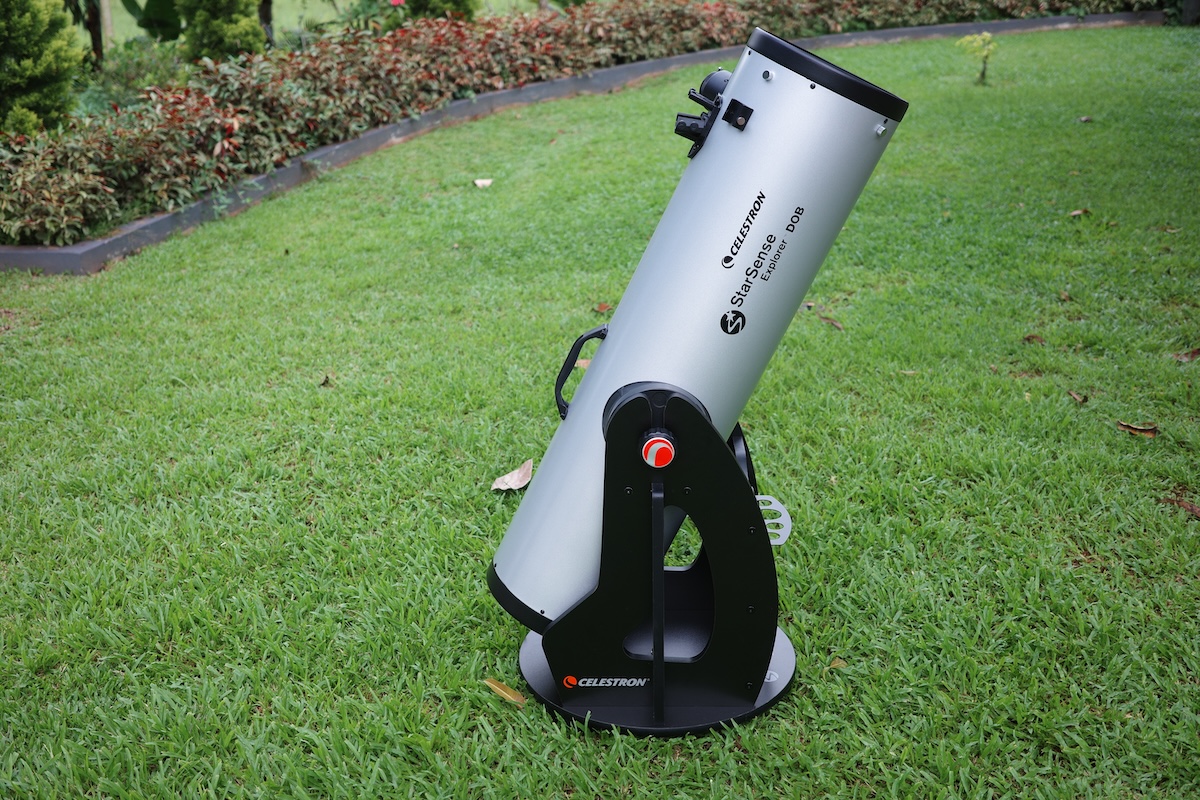The Optical Tube
The StarSense Explorer 10” Dobsonian is optically a 10” (254mm) f/4.7 Newtonian reflector with a focal length of 1200mm.
About the Tube’s Portability and Size
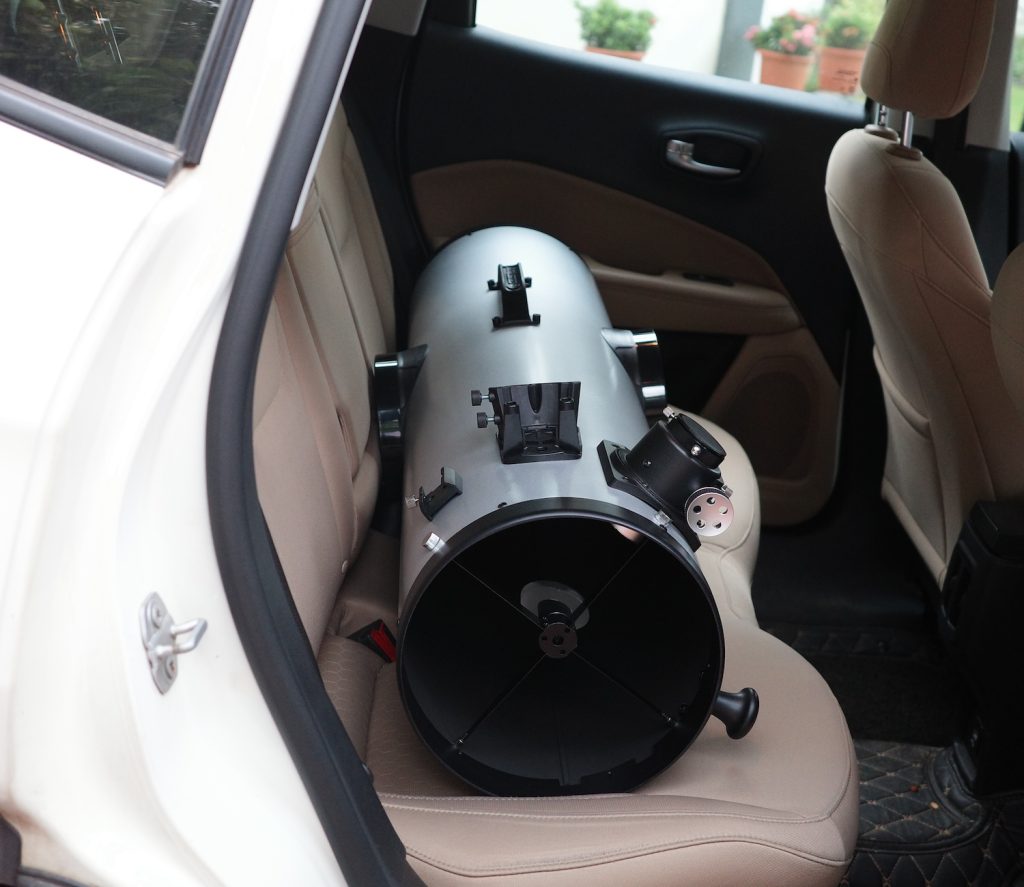
The tube of the StarSense Explorer 10” Dob is about 48” long, the same as most 8” dobsonians and full-sized 6” dobsonian scopes with only slightly more weight and a wider form factor. It can be easily fitted across the back of many vehicles, like what I’ve shown in the picture above. But it does take up the whole back seat.
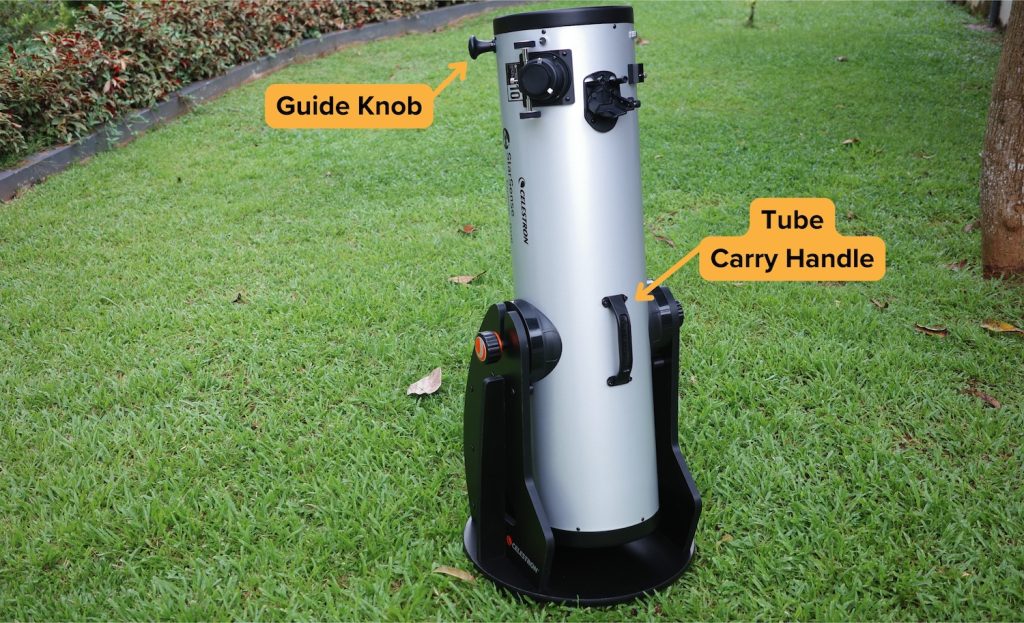
A Note on the Effect of f/4.7 Focal Ratio on Eyepiece Performance
At f/4.7 focal ratio, some popular eyepieces I own, such as “SuperView” or “SWA,” showcase edge-of-field astigmatism and field curvature (making it look like I’m viewing at warp speed or from inside a fishbowl).
I’ve also particularly noticed that almost any low-power eyepiece with a true field of view much wider than the included 25mm Plossl eyepiece has an obvious coma around the edges of the field of view.
Coma is easily ignored and often masked by other eyepiece aberrations; edge-of-field astigmatism and field curvature are less so. This is important to keep in mind when you’re shopping for new eyepieces.
Of course, the cheap, poorly corrected wide-angle eyepieces practically thrown in for free with similarly fast scopes are better than nothing. But paying large sums for them to use with the StarSense Explorer 10” Dobsonian isn’t as logical, especially for a scope that already costs several hundred dollars more than the more well-equipped competition that I love, the Apertura AD10.
Collimating The 10″ StarSense
Collimating a faster focal ratio telescope like an f/4.7 is slightly more difficult than a slower instrument. I had to collimate the telescope pretty frequently, though not every time I set up the scope. But it’s not a particularly difficult process.
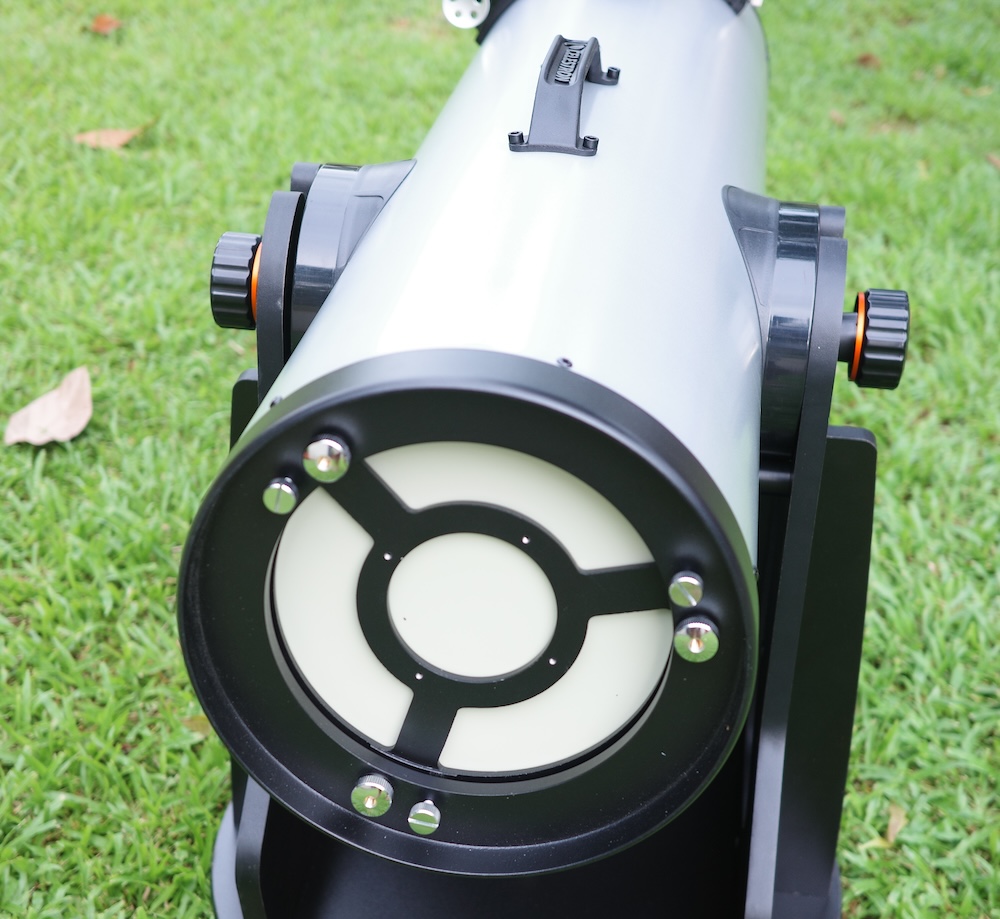
Unlike the 8” StarSense Explorer dobsonian model, the StarSense Explorer 10” doesn’t require a screwdriver to adjust the primary mirror. There are collimation screws below the mirror cell on the back of the optical tube, as shown above. However, since no collimation tools are provided, you’ll need to make or purchase one separately.
A Focuser with a Few Shortcomings
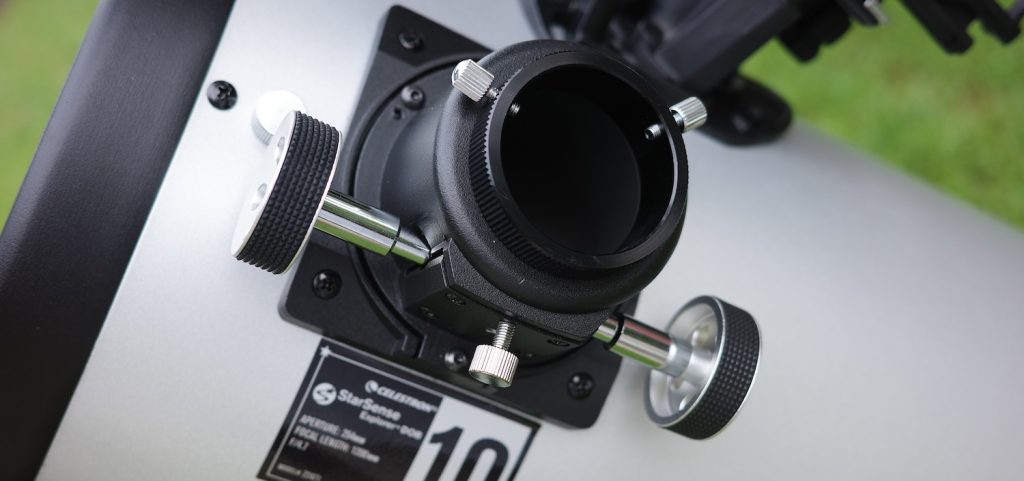
The single-speed Crayford focuser can be upgraded to a dual-speed unit, but most upgrade kits (sold usually for Sky-Watcher focusers) I’ve seen are not labelled as compatible and are often not available in the United States.
I believe that a dual-speed unit should really have been included at such a high price that Celestron charges for the scope. I’m not saying that a single-speed focuser isn’t fine for general use, but for such a fast scope at high magnifications, a 1:10 dual speed reduction would’ve been helpful in easily dialling in focus (especially if you lack a very steady hand).
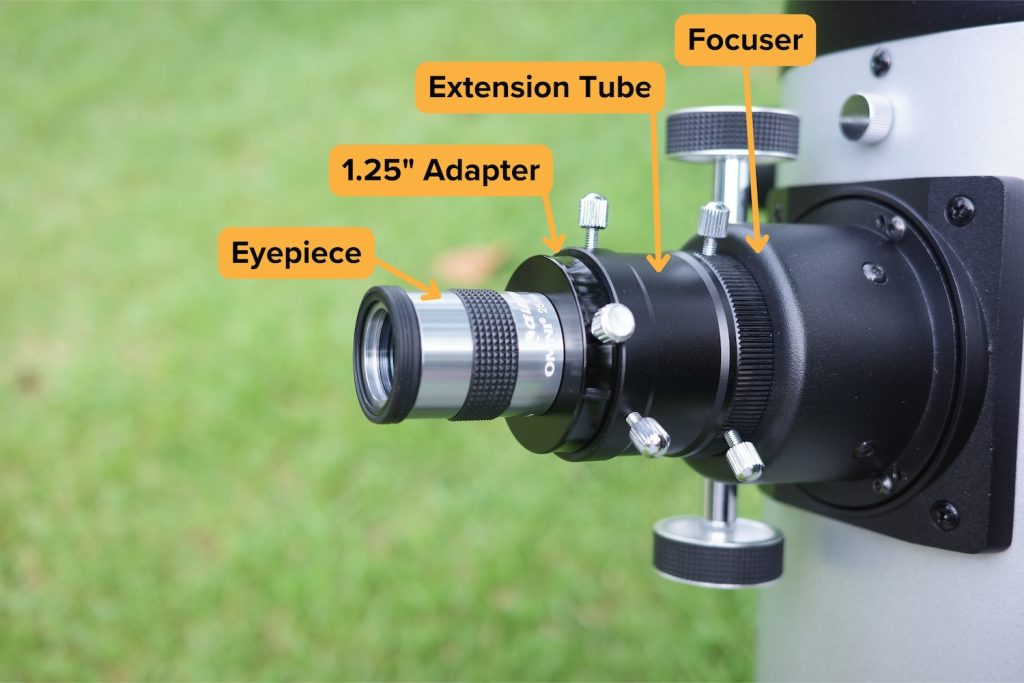
The supplied focuser uses thumb screws to grip an extension tube (required for most eyepieces to reach focus). The extension tube also uses thumb screws to grip the eyepieces. Most well-made focusers and extension tubes I’ve seen use compression rings to grip our eyepieces, and the provided 1.25” adapter uses one too.
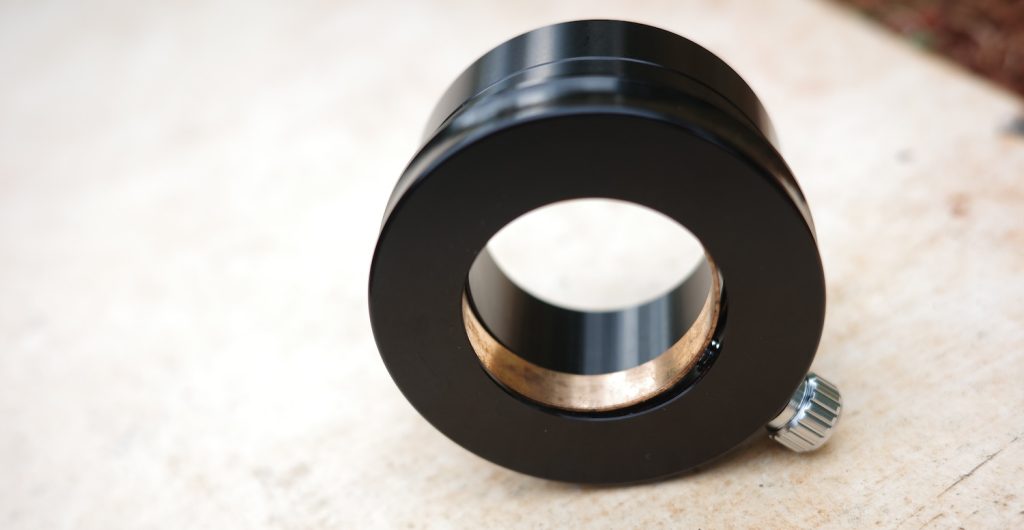
I replaced the provided extension tube with one that uses a compression ring to provide a more secure, non-marring connection for my 2” eyepieces. But for a $1000+ telescope, this is really inexcusable that I had to do it.
The Supplied Accessories
The StarSense Explorer 10” Dobsonian includes a 25mm Plossl (48x) with a 55-degree apparent field of view.
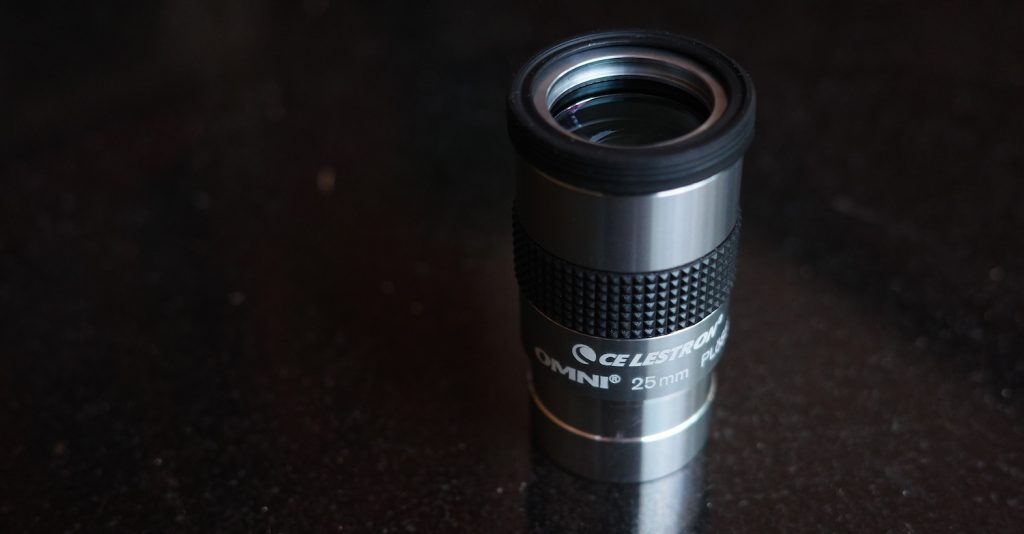
The eyepiece works well enough at f/4.7, but you’ll probably want to pick up some additional eyepieces to enhance your observing experience (100x or above is needed for good views of planets and globular star clusters, for example).
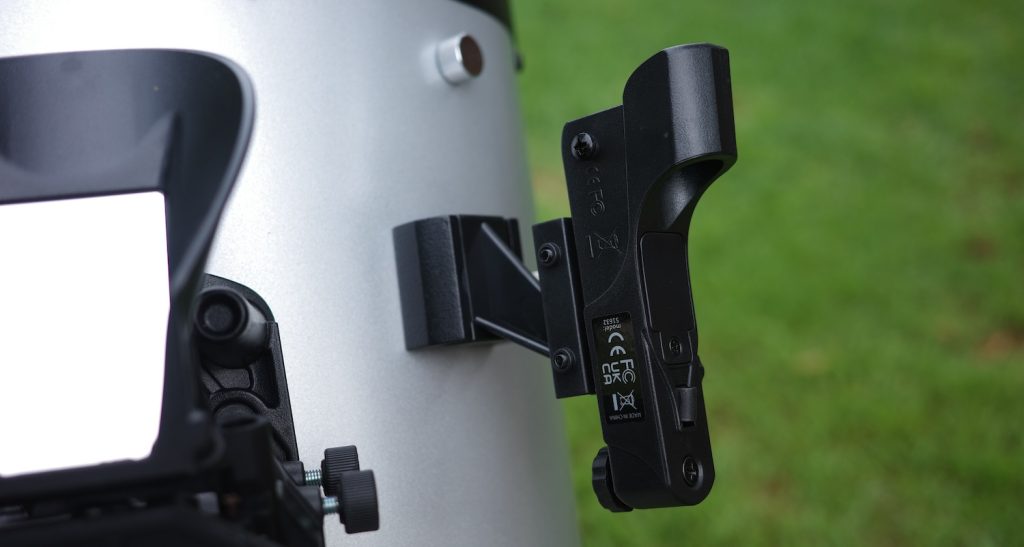
The red dot sight is more than adequate for a finder, especially since you’ll probably be using the StarSense Explorer app to aim the scope most of the time anyway.
Mount
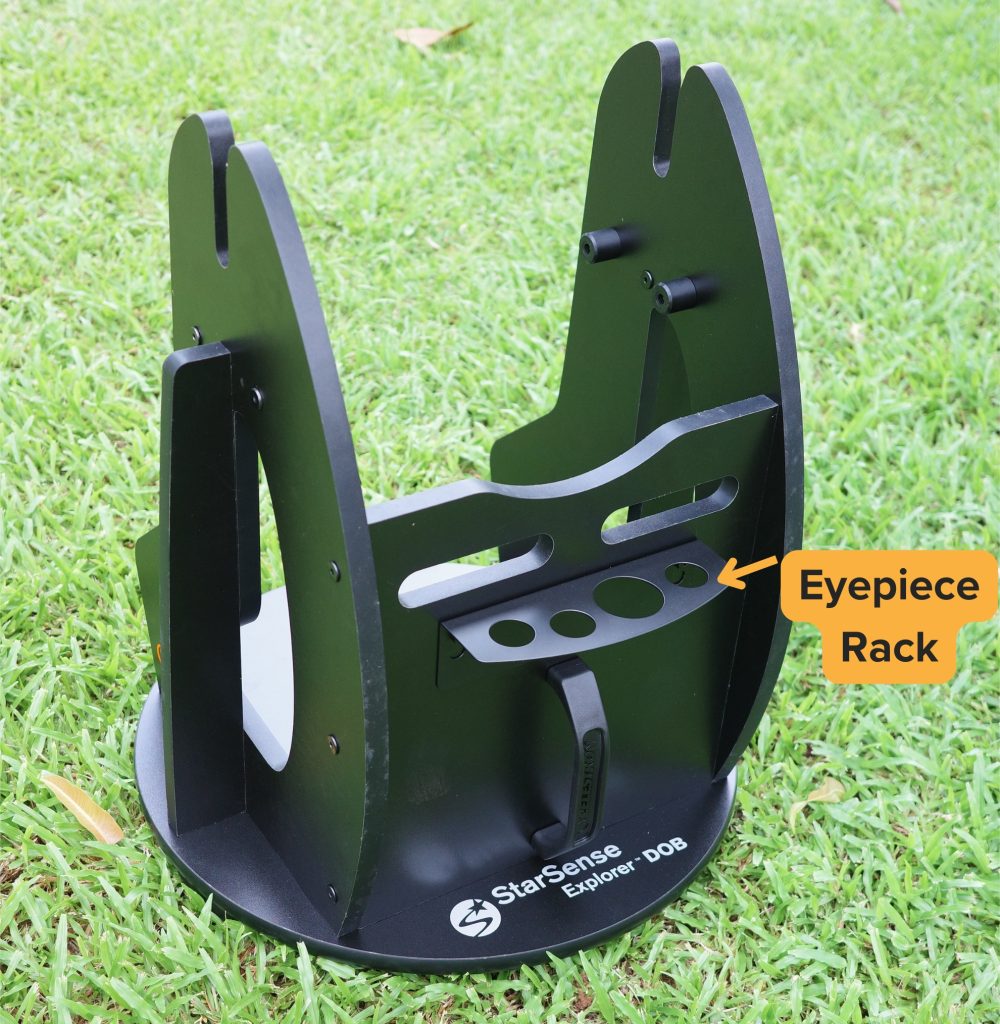
The StarSense Explorer 10” Dobsonian is, of course, a Dobsonian telescope, an alt-azimuth that pivots up and down on plastic bearing pads and swivels left-right like a “lazy Susan” on a set of three plastic pads arranged in a triangle above the feet on the base. There are no gears, locks, or cables. There’s an eyepiece rack on the front.
The base is made out of melamine-covered particle board and is thus heavier than it initially looks. Thankfully, Celestron has added cutouts to the base to act as handles and to keep the weight to a minimum.
I assembled it myself with a hex key when it arrived, just like knock-down furniture.
The altitude axis on the StarSense Explorer Dobsonians does have a clutch/brake on it similar to the one on the Sky-Watcher Dobsonians. You can, in principle, tighten the knobs on the sides of the bearings to increase friction. The main actual purpose of this is to lock the telescope in place if you use a heavy 2” eyepiece, which will upset the balance of the scope by moving the center of gravity outside the bearings, leading to it tipping over when aimed low in the sky. However, locking the bearings, of course, inhibits smooth motion.
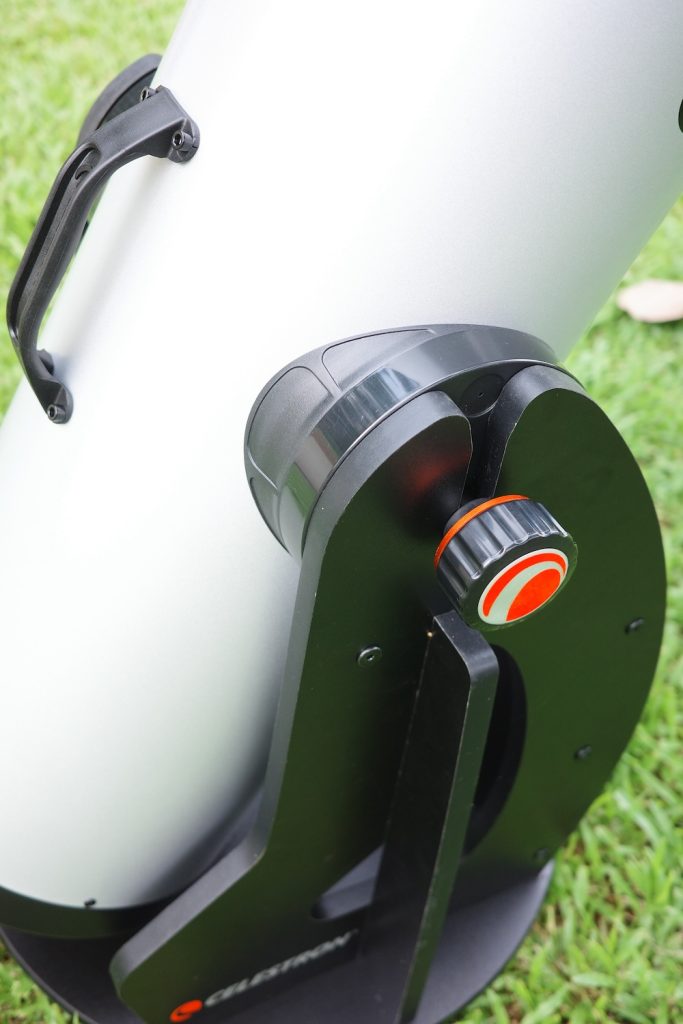
The real solution is either a counterweight or a better mount design, such as Dobsonians that use spring tensioning or simply larger bearings. It’s possible to retrofit larger bearings onto the scope and build a new plywood base to match, but this is expensive to have custom-made and time-consuming to construct yourself.
Should I buy a Used Celestron StarSense Explorer 10”?
The Celestron StarSense Explorer Dobsonians are very new to the marketplace, so it’s unlikely you’ll find one with any kind of issues due to long-term neglect. However, as always, you should check the quality of the mirror coatings and make sure there is no obvious, severe damage.
Aftermarket Accessory Recommendations
The StarSense Explorer 10” really needs additional eyepieces. A 15mm SVBONY wide-angle eyepiece (80x) will provide a nice medium magnification for many deep-sky objects. A 9mm gold-line or red-line (133x) provides medium-high power for smaller deep-sky targets and for the Moon and planets. A 6mm gold-line or red-line will give you 200x for optimal views of the planets and splitting double stars. On a good night, a 10” Dobsonian can handle up to 500x magnification, but you’re seldom likely to have good enough conditions to use such high magnifications, and the benefit is questionable, especially considering the cost of a good short-focal-length planetary eyepiece.
At the low power end, a 34mm SWA eyepiece (35x) is about the lowest magnification you can use and will provide a huge field of view (2 degrees across), but you’ll definitely see coma and edge-of-field astigmatism, and the bright sky background will make it useless in light-polluted conditions. You might also have some balance issues with such a big and heavy ocular. A coma corrector is worth considering with the StarSense Explorer 10”; the Baader MPCC MKIII works well but must be repeatedly screwed and unscrewed onto your low-power eyepieces (or left on your widest-field ocular).
While not a be-all, end-all solution for light pollution and only actually working on certain nebulae, a UHC (ultra-high-contrast) narrowband filter is great for viewing nebulae regardless of sky conditions; even under dark skies, the contrast improvement is noticeable.
What can you see with the StarSense 10″ Dobsonian?
A 10” Dobsonian is a great choice for beginners and can show you significantly more than a smaller 8” or 10” without a huge increase in bulk or a claustrophobically long focal length. You can probably move the scope fully assembled if you’re in good shape, take two trips to set it up in your backyard, or stick it on a hand truck or dolly. The StarSense Explorer 10” Dobsonian should be able to resolve most of the globular star clusters in the Messier catalogue and many of the brighter NGC globular clusters. M13’s “propeller” dust lanes show up at high magnification, M15’s bright nucleus is dazzling, and you can spot G1, a globular cluster millions of light-years away orbiting the Andromeda Galaxy, as a tiny, fuzzy dot if you can identify it amongst the stars.
Open star clusters are colourful and often show wisps of nebulae or dust lanes under dark skies. The wispy nebula surrounding the Pleiades (M45) can be seen under reasonably good conditions, though it’s easy to confuse with glare or smudges on your eyepiece. Emission nebulae like the Swan (M17), Lagoon (M8), and Orion Nebula (M42) are bright and look especially good under dark skies and/or with a UHC filter. The Horsehead Nebula can be seen under dark skies with a good UHC filter too, though the nearby Flame Nebula is much more obvious due to its brightness and size. The Veil Nebula dazzles under dark skies with a UHC filter, spanning several degrees across and requiring you to sweep the telescope around to see the whole thing. Small planetary nebulae are great too; some, like the Cat’s Eye, are green or blue in colour and show tiny details during moments of good seeing if you’re using a good high-magnification eyepiece.
Galaxies are the most numerous deep-sky objects available, and 10” of aperture allows you to see a lot of them—theoretically, some number in the tens of thousands, though most will be dim, devoid of detail, and often easy to miss at first glance. However, the entire Herschel 400 list and Messier catalogue are easy to see; the Virgo Cluster is populated with hundreds of easily-visible targets; and dimmer clusters like those in Fornax, Coma Berenices, and Pegasus are possible to observe too. Bright galaxies like M65, M31, M82, M64, M104, and NGC 7331 show obvious dust lanes even with moderate light pollution. The spiral arms of a few galaxies, such as M51, M81, M101, and M33, can be seen if you have dark skies and a careful eye, though don’t expect anything super obvious or easily visible with direct vision.
A 10” scope is about the biggest where you can regularly expect to see tangible gains in lunar and planetary views from more aperture; larger scopes only truly live up to their capabilities under exceptional seeing conditions (though their other advantages do stack up well). The Cassini Division in Saturn’s rings is easy to see, along with cloud belts, a smattering of moons, including the orange-gold Titan, and, under very good conditions, the Encke gap in the planet’s rings can also be seen.
Jupiter’s cloud belts are bold and brilliant, with the Great Red Spot immediately visible at high magnification and detailed within. Jupiter’s four large Galilean moons are all usually resolvable into disks, and their jet-black shadows make for a striking contrast when they transit in front of the planet. A brown spot on Ganymede, Galileo Regio, can also be seen under exceptional conditions. Uranus and Neptune are obviously disks; a few of Uranus’ moons can be faintly seen, and Neptune’s moon, Triton, is fairly easy to spot. Pluto is, of course, a star-like point, but you can definitely see it with a 10” scope even as it dims as it retreats further from the Sun.
Venus and Mercury are devoid of detail visually in any amateur telescope, but you’ll probably have an easier time finding and resolving Mercury with a bigger scope like the StarSense Explorer 10” Dob. You’ll be able to see the polar ice caps and a few dark markings on Mars; skilled observers can also find Deimos and maybe even resolve geological features like Olympus Mons and Valles Marineris, given very good conditions when Mars is at its closest to Earth. And the Moon is, of course, jaw-dropping under any conditions and at any magnification level with a high-quality big Dobsonian.

